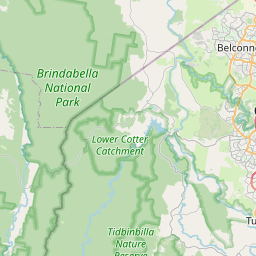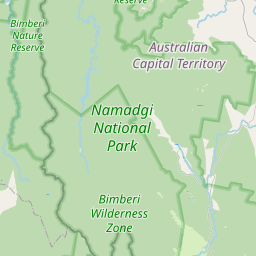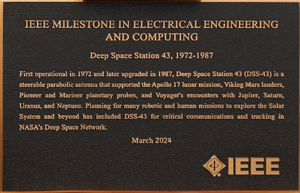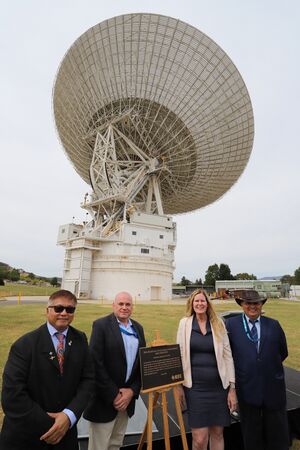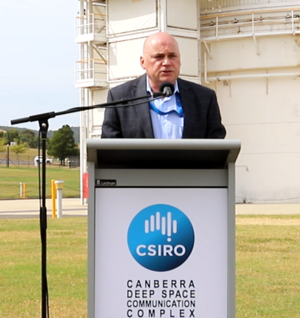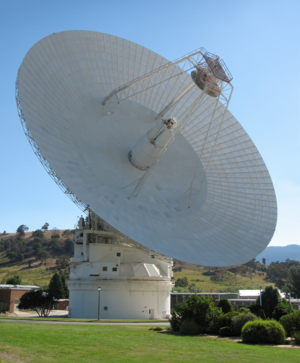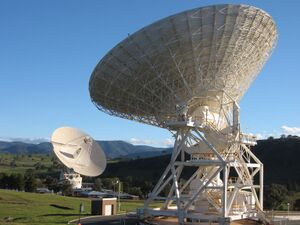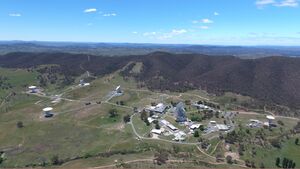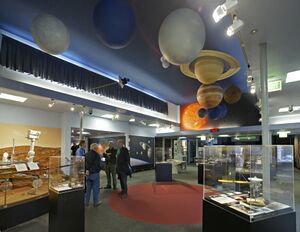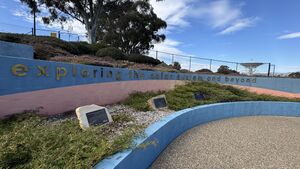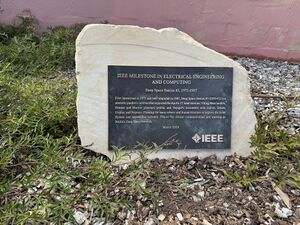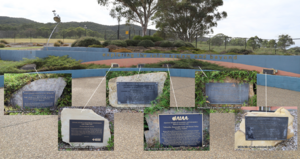Milestones:Deep Space Station 43, 1972-1987
- Date Dedicated
- 2024/03/06
- Dedication #
- 248
- Location
- Paddy's River District ACT
- IEEE Regions
- 10
- IEEE sections
- Australian Capital Territory
- Achievement date range
- 1972-1987
Title
Deep Space Station 43, 1972-1987
Citation
First operational in 1972 and later upgraded in 1987, Deep Space Station 43 (DSS-43) is a steerable parabolic antenna that supported the Apollo 17 lunar mission, Viking Mars landers, Pioneer and Mariner planetary probes, and Voyager's encounters with Jupiter, Saturn, Uranus, and Neptune. Planning for many robotic and human missions to explore the Solar System and beyond has included DSS-43 for critical communications and tracking in NASA’s Deep Space Network.
Street address(es) and GPS coordinates of the Milestone Plaque Sites
421 Discovery Drive, Paddy's River District ACT 2620 Australia (GPS: -35.4026029, 148.9806286)
Details of the physical location of the plaque
The IEEE plaque is one of 6 commemorative plaques mounted on rocks in the DSS-43 Visitor Centre plaque garden, and it's positioned 2nd from the left.
How the plaque site is protected/secured
The CSIRO Canberra Deep Space Communications Complex (CDSCC) is a secure facility; the Visitor Centre and its plaque garden are publicly accessible during at least normal business hours.
Historical significance of the work
The Tidbinbilla Deep Space Tracking Station, also known as Deep Space Station 43 (DSS-43), was constructed from 1969 to 1973 as a 64-metre diameter antenna. It was more than six times as sensitive as DSS-42, the original 26-metre antenna at the Canberra Deep Space Communication Complex (CDSCC) at Tidbinbilla near Canberra, Australia. The primary purpose of the station's antennas is to track spacecraft and space probes for NASA and other space agencies.
DSS-43 supported, as needed, the Apollo 17 mission to the Moon before the antenna's dedication and official opening in 1973. Viking 1 and 2 missions were also supported in June-July 1976 when they were the first human landers on Mars. The Canberra dish handles nearly 42% of all data emanating from celestial explorers like Voyager, New Horizons, and the Curiosity rover, and it has also enabled the world to see dazzling pictures of Mars and Pluto.
DSS-43 was extended from a 64-metre diameter antenna to a 70-metre diameter in 1987 to enhance its capabilities for the Voyager 2 1989 encounter with Neptune. It is the largest steerable parabolic antenna in the Southern Hemisphere. The massive structure, weighing more than 3000 tonnes, rotates on a film of oil approximately 0.17-mm thick. The reflector surface is made up of 1,272 aluminium panels with a total surface area of 4180 square metres. The outer panels are perforated, allowing rain and wind to pass through them.
NASA plans to send future generations of astronauts from the Moon to Mars, and DSS-43 will play an important role as part of NASA's Deep Space Network.
Obstacles (technical, political, geographic) that needed to be overcome
Communication with an object located outside of our solar system requires a dish with extraordinary technical accuracy, and this is made possible with an RMS surface flatness of 250 microns (.25 mm) and a pointing accuracy of 0.005 degrees (18 arc seconds). This accuracy, coupled with the dish’s gain of 74.8 db and extremely narrow beamwidth of 0.0038 degrees, together enables communications to the incredible distance from Earth of more than 23 billion kilometers when the Voyager spacecraft is beyond Pluto. No other dish in the southern hemisphere even comes close to these technical specifications.
As a result of the Voyager 2’s flyby of Neptune's moon Triton in 1989, its trajectory steered significantly southward relative to the Solar System's plane of planets, resulting in northern hemisphere antennas having no way of reaching it. As a result, DSS-43 in the southern hemisphere is the only dish on Earth able to communicate with Voyager 2, which is almost 20 billion kilometers from Earth as of 2023. When it is eventually updated with more sensitive receivers and more powerful transmitters, the DSS-43 antenna will continue to be able to communicate with the Voyager spacecraft (and others) as they travel deeper into interstellar space.
The obstacles that had to be overcome during the construction of DSS-43 were also exceptional. From the accuracy of the foundation of the site, to the building’s accuracy, and to the rotational structure of the telescope, together required a total systems accuracy across the base of the antenna of 0.25 mm. In RF systems communicating across the vast reaches of the solar system and beyond, mechanical accuracy is key to the success of the electrical systems. Even an error of +/- 0.1 mm would result in pointing errors in the tens of thousands of kilometers at the tens of billions of kilometers distance of the Voyager spacecraft. The accuracy requirement extends to the design of the antenna structure and the feedhorn, as well as to the center of axis of the feedhorn itself.
All of these aspects of the system's design and accuracy together enable communication over distances that were unthinkable before the inception of DSS-43 and its compatriots around the world.
Features that set this work apart from similar achievements
When it comes to making a long-distance call, it's hard to top NASA's Deep Space Network. It’s the largest and most sensitive scientific telecommunications system in the world.
The Deep Space Network - or DSN - is NASA’s international array of giant radio antennas that supports interplanetary spacecraft missions, plus a few that orbit Earth. The DSN also provides radar and radio astronomy observations that improve our understanding of the solar system and the larger universe.
The DSN is operated by NASA's Jet Propulsion Laboratory (JPL), which also operates many of the agency's interplanetary robotic space missions.
The Deep Space Network (DSN) is operated by NASA's Jet Propulsion Laboratory (JPL), which also operates many of the agency's interplanetary robotic space missions. The DSN consists of three facilities spaced equidistant from each other – approximately 120 degrees apart in longitude – around the world: Goldstone, near Barstow, California; near Madrid, Spain; and near Canberra, Australia, which includes DSN-43. The strategic placement of these sites permits constant communication with spacecraft as the Earth rotates – before a distant spacecraft sinks below the horizon at one DSN site, another site can pick up the signal and carry on communicating. Nearly 42% of all data emanating from celestial explorers like Voyager, New Horizons, and the Curiosity rover comes through DSS-43, whose communications operate in these bands: Transmit: X and S; Receive: X, S, L, and K.
The antennas of the Deep Space Network are the indispensable link to explorers venturing beyond Earth. They provide the crucial connection for commanding our spacecraft and receiving their never before seen images and scientific information on Earth, propelling our understanding of the universe, our solar system and ultimately, our place within it. Without the exceptional gain of the dish, coupled with its exceptional mechanical and electrical precision, it would be impossible to communicate with spacecraft beyond the edge of our solar system. Even today DSS-43 is unique in its ability to send commands to the Voyager spacecraft, and is key to our growing understanding of the environment of space beyond where any human spacecraft has flown.
Significant references
- https://www.nasa.gov/directorates/heo/scan/services/networks/deep_space_network/about
- https://www.cdscc.nasa.gov/Pages/cdscc_history.html
- https://www.cdscc.nasa.gov/Pages/cdscc_historyapollo.html
- https://theconversation.com/australias-part-in-50-years-of-space-exploration-with-nasa-24530
- https://ieeexplore.ieee.org/document/6929988
- https://www.readtheplaque.com/plaque/deep-space-station-43-ballima
- https://www.cdscc.nasa.gov/Pages/Antennas/dss43.html
- https://www.csiro.au/en/news/all/articles/2023/april/deep-space-station-43
- https://www.nasa.gov/directorates/heo/scan/txt_news_dss43.html
- https://www.nasa.gov/feature/jpl/nasa-s-deep-space-network-looks-to-the-future
- https://www.nasa.gov/topics/moon-to-mars
- https://www.adelaide.edu.au/newsroom/news/list/2021/06/18/researchers-on-a-mission-from-the-moon-to-mars
- https://ieeemilestones.ethw.org/w/images/1/12/VikingMissionSupport%28JPL-Report%29.pdf
- https://www.sciencealert.com/nasa-finally-makes-contact-with-voyager-2-after-long-spell-of-radio-silence
- https://blog.csiro.au/deep-space-station-43-upgrade/
- https://simplediscoveries.com/canberra-deep-space-network/
Supporting materials
IEEE Spectrum story:
Dedication Ceremony
Map
